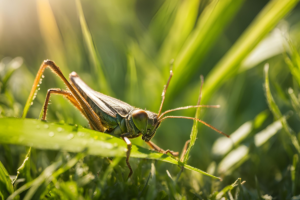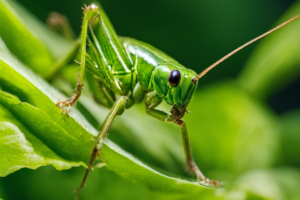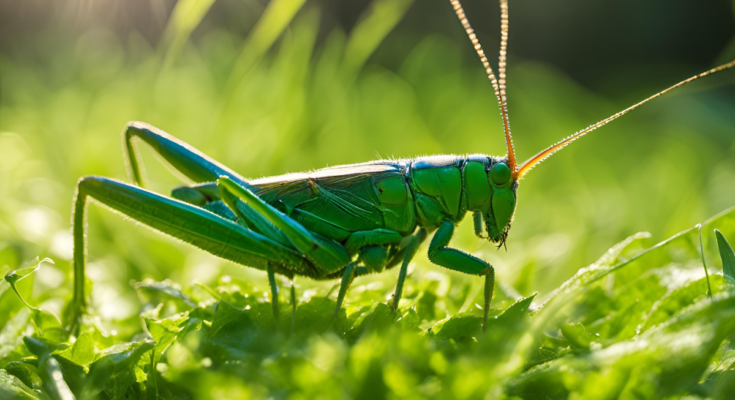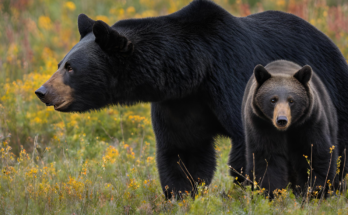These crawling invertebrates exist as critical agents in maintaining natural habitats together with influencing human activities. Understanding the diet of crickets demands fundamental knowledge of what produces their nutrition for anyone keeping pets raising feeder insects or engaging in general cricket study. Through this detailed examination, we will analyze the eating patterns and nutritional requirements of crickets while comparing their natural diet to their habitat-based diet plan. You will understand thoroughly the best nutritional practices for these versatile insects after following this guide.
1. Introduction to Crickets and Their Diets
Small Orthoptera insects exhibit cylindrical morphology along with extended antennae and strong hind-leg structures. Crickets live throughout the world everyplace except Antarctica and they thrive across various environmental areas that span from grasslands to forests. Their ability to adapt extends to dietary preferences which explains their great population success.
Omnivorous crickets need to be understood for a complete understanding of their dietary variables. Crickets use plant and animal substances in their diet to collect all necessary survival and reproductive nutrients. A cricket’s diet determines both its personal health and well-being and the health state of the animals if they are used as feeder insects.
2. What Do Crickets Eat in the Wild?
Crickets demonstrate an opportunistic eating pattern when they inhabit their natural habitat. Crickets exist as opportunistic eaters who take whatever food items exist within their wild environment because they adjust their dietary choices based on season cycle and habitat factors. Here’s a breakdown of common foods crickets eat in the wild: The animals take what their setting provides while their dietary choices vary depending on both seasons along with their environment. Here’s a breakdown of common foods crickets eat in the wild:
Plant-Based Foods
- Grass and Leaves: Besides grass and leaves cricket populations seek out vegetation as a significant food source.
- Flowers and Fruits: Changes in diet consist of dead blossoms and ripe fruits along with other natural foods that contain high nutritional value.
- Seeds and Grains: The small seeds make up an important part of the crickets’ high-energy food diet.

Animal-Based Foods
- Small Insects and Larvae: Carnivorous crickets choose to seek and eat smaller insects combined with aphids and larvae.
- Decaying Organic Matter: When serving as scavengers crickets tend to eat decomposing plants and animals.
The cricket’s broad dietary behavior provides a foundation for enduring survival along with environmental flexibility. Through their diverse diet crickets play two crucial roles in maintaining ecological stability by breaking down organic materials while controlling pest populations.
3. What Do Crickets Eat in Captivity?
Crickets require specific dietary control during captivity for both feeder insect and pet purposes and food consumption. When keeping crickets in captivity their dietary needs include both proper nutrition balance and variety in their food options. Crickets need proper nutrition management so owners can give their pets and feeder insects and human consumers healthy and nutritious food. Healthier crickets enhance food nutrition that proceeds to the consumers both human and animal.
Common Foods for Captive Crickets
- Vegetables: The nutritional selections for captive crickets encompass carrots squash and potatoes in addition to leafy greens such as kale or spinach. These food items offer complete nutritional benefits.
- Fruits: Consuming apples together with oranges and bananas offers humans and animals important benefits from vitamins and hydration.
- Grains and Cereals: The combination of wheat germ with oats and baby rice cereal provides a nutritious and comfortably digestible food source.
- Protein Sources: Top protein sources include tropical fish flakes along with cat food pellets for captive crickets.

Homemade Cricket Food
The combination of grains fruits vegetables with a reptile vitamin and calcium supplement produces an excellent homemade diet for crickets. Check regularly that your food stays fresh with no mold present.
Hydration
To stay hydrated crickets must have access to water. Water gel or a small water dish is crucial to use as crickets need both items to stay hydrated safely. Orange fruits alongside melons operate as suitable hydration sources for crickets.
4. The Importance of Gut Loading for Feeder Crickets
Herpetoculture practitioners prepare crickets for feeding pets by first giving them nourishing food which improves their nutritional value for reptiles or amphibians. This practice is known as gut loading. Gut-loading cricket feeder insects represent a stellar response to “what do crickets eat” when used for pet food. Here’s how you can gut-load crickets effectively: Pet reptiles and amphibians should receive feeder crickets only after proper gut loading through nutritional feeding. Gut loading provides necessary nutrients that transfer successfully to reptiles through cricket consumption. Here’s how you can gut-load crickets effectively:
Ideal Gut-Loading Foods
- Dark leafy greens (mustard greens, collards
- Sweet potatoes
- Squash
- High-quality cricket chow
Benefits of Gut Loading
- Gut loading boosts crickets’ nutritional content.
- The process helps pets stay healthier by decreasing their likelihood of nutritional deficiencies.
- The process ensures crickets maintain proper nutritional value during their intake of food by pets.
Gut loading should be done 24-48 hours before feeding the crickets to your pets.
5. Foods to Avoid Feeding Crickets
Watching how crickets adapt their diet remains essential to recognizing the food sources they need to stay away from. Starving crickets and the animals eating them occur when certain foods reach either insect or wildlife species. Avoid feeding crickets: Particular food items can cause damage to crickets as well as to both crickets and the animals that eat them. Avoid feeding crickets:
- Citrus Peels: Masochistic elevations regarding citrus fruit occur when seeking to avoid dangerous peel contact.
- Processed Foods: Chips alongside cookies along with other salty or sugary snacks make unacceptable foods for crickets.
- Toxic Plants: Dangerous plants include rhubarb as well as tobacco and ivy.
- Moldy or Rotten Food: Fresh food must always be provided because spoiled food increases the risk of bacterial infections.
6. Best Practices for Feeding Crickets
The success of your cricket colony depends upon having proper knowledge regarding what crickets consume. Following these feeding tips ensures that your crickets remain healthy and productive: follow these feeding tips:
- Variety is Key: Your crickets require a nutritional mix containing fruits and vegetables alongside grains as their dietary foundation.
- Feed Regularly: Food set out each day should have excess leftovers taken out to stop mold formation.
- Clean Habitat: The enclosure must remain free of contamination so both food and water stay untouched.
- Monitor Health: When crickets remain healthy they stay active and develop a shiny external coating. When crickets display signs of slowness or weakness they should get their diet adjusted.
[Insert Image Prompt: “A clean cricket habitat with fresh food and water sources.”] [Alt Text: “A tidy cricket enclosure with fresh vegetables and a small water gel container.”] [Title: “Ideal Cricket Habitat”]
Sustainability of Cricket Farming
The growing interest in cricket farming is driven by minimal environmental strain coupled with sustainable dietary solutions addressing “what do crickets eat”. These insects are considered “micro-livestock” because they: are due to their low environmental impact. These insects are considered “micro-livestock” because they:
- Require Minimal Resources: Crickets need minimal water resources, land, and meal usage and they remain more sustainable than traditional meat production.
- Reproduce Rapidly: During her life span, one female cricket lays hundreds of eggs.
- Reduce Food Waste: Crickets survive by consuming food waste which turns into a species-safe protein food source.
Conclusion
An understanding of what crickets need to eat stands as a fundamental requirement for anyone who looks after crickets or seeks to raise them. Each section described cricket food diversity starting with vegetation and ending with small prey which demonstrates their ability to adjust along with their key position in ecological systems. For people caring for or raising crickets. They can feed on plant-based foods combined with small insects to demonstrate both their evolutionary flexibility and their ecological value. Wild and captive cricket populations maintain health through balanced diets which ultimately delivers benefits to both human and animal consumers of crickets.
Practices involving best feeding methods together with gut-loading techniques alongside sustainability principles enable optimal cricket care while advancing the environmental stewardship of the future. The simple classification of crickets as insects belies their central role in nature together with their growing position as an eco-friendly resource.

